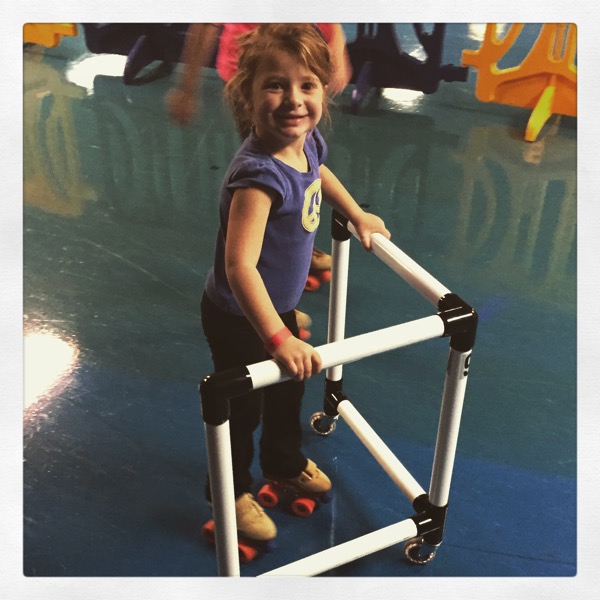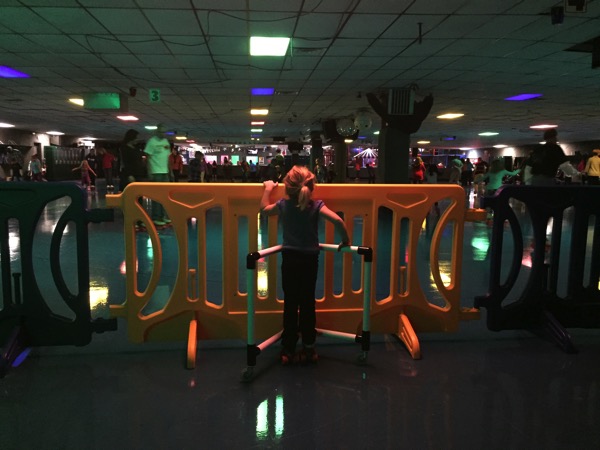Last month, I took my three daughters skating. They’ve all been to the skating rink plenty of times, and are at different levels of skating expertise. Ani and Teagan both motor along at their own paces, leaving their four-year-old sister, Quinn, and me behind as they skate it up to whatever loudly pulsating track is pounding through the speakers of the skate sound system. Ani will even play some of the inevitable games that creep up during a perfectly fine all-skate, limbo-ing her way into the second or third round of competition.

Quinn, though, until last month’s trip, had never put skates to feet. Her idea of roller skating was playing in a big indoor jungle gym they’ve set up for the pre-skating crowd. But it was time.
When my older daughters learned to skate, they pretty much just fell down. A lot. Until they figured out the mechanics of wheels on their feet and their centers of gravity. Quinn had some new options. In the picture to the left here, you can see the frame on wheels she used to help her find her way with a little less falling down.
And while she was trying out the skates and the helper contraption, she had a safe space on the skate floor, behind a row of colored barriers, set up for new skaters and their teachers. Her sisters on the other side of the barrier could see her progressing and she could wave and smile as she scooted across the floor.
But the greatest thing about the divided skate floor was that she could see the “real” skating world she was learning to use. She could get there at any time, and, in many ways, it was the same place she was skating in. She was skating with everyone else, even though she was off to the side.
Quinn was immersed in a real-world learning experience – not separated from it. She wasn’t in a special carpeted room that bore no resemblance to what skating was really like. She grooved to the same music, heard the same announcements, and could smell the same pizza ((I’m not certain the pizza smell, as good as it was, was entirely necessary.)).
I’m probably making too big a deal about it, but I find that lots of learning spaces don’t ever really resemble the environments where the learning gets put into practice. The learning, too, doesn’t resemble the way that life or work or whatever the students are learning about is enacted in the “real world. ((The mythical real world is a fascinating place for me. It’s often invoked as a reason why an experience has to be terrible, or hard, or boring, or involve showing one’s work – but I’ve not found the “real world” to be necessarily boring or work-showing. The “real world” is often what we make it to be, and can be pretty great.))
I loved Quinn’s experience because she was immediately in control of her experience – she could lose the cage and leave the protected area whenever she wanted. But it was also connected to the goal she set for herself – to skate like her sisters. It wasn’t a walled garden. It was the actual garden – she just had some extra tools to help her make sense of her experience and transition out of the training area. I guess in a way she was in the garden with some hedges – but not walls or gates or anything exclusionary or separating.
If the learning you’re facilitating, or the learning space you’re facilitating it in, doesn’t resemble OR connect to the places or opportunities you’re attempting to connect your students to, then it seems to me that you’re doing it wrong.
How many contrived spaces do we build for students, spaces that don’t even approach the real world, much less connect to it? What does it mean to build classrooms or learning spaces that connect, physically or otherwise, to the spaces we are teaching our students about?
Take a look at the picture below of Quinn gazing over the boundary between her classroom and the real world. She’s curious and eager and ready to move beyond the barrier – when she is ready, that’s just what she’ll do ((And part of my job as her teacher there in that moment was to not push her too fast, but to provide some steady pressure. Her goal was to get out on the floor, not to muck about forever with the support structure. Knowing just how much pressure is the right amount is an area of my practice as a teacher AND a parent that I’m certain I’ll never quite master.)).
At least sometimes, learning should look like that.

New Post: Skating Along: Last month, I took my three daughters skating. They’ve all been to… http://t.co/CltDSONtk1 by @budtheteacher
Skating Along http://t.co/D784lnxIXO
Walled gardens? Nah. How about gardens with porous walls? http://t.co/stoEm9IFvR
@budtheteacher Sieves, even. BTW: your daughter
Has a GREAT name 🙂
Skating Along #academics http://t.co/Ub5gyR8o7H
What a great lense to look through while reflecting on our practices in the classroom. This really hit home with me on many levels…as a special education teacher, as a school technology contact, and as a teacher in the 21st century. Thanks!
Bud, you gentle-hearted Papa, Quinn’s story evokes a bright array of learningful thoughts. There’s even some Zone of Proximal Development here. Perhaps most touching is Quinn’s longing look across the barrier to the Big Kids’ World. Who doesn’t want to do what the Big Kids are doing? Where’s that opportunity in school?
Skating Along http://t.co/oZWsJZjzUj > a powerful story and analogy #plpnetwork
RT @lanihall: Skating Along http://t.co/oZWsJZjzUj > a powerful story and analogy #plpnetwork
Gregory Fell liked this on Facebook.
Learning should resemble how life/work is enacted in the real world. Skating Along | @BudtheTeacher http://t.co/P5GZ8QCG8R
@KtameliaW Great reflection on learning spaces being like real life. http://t.co/z5badYBvWl